For a long time pickup trucks have been more than just vehicles; they’re a statement. As the catchy tune of Joe Diffie’s “Pickup Man” suggests, the loyalty of a pickup owner runs deep. “You can set my truck on fire, roll it down a hill, but I still wouldn’t trade it for a Coupe DeVille.” This sentiment resonates with many, especially those who appreciate the rugged utility and iconic symbolism of these American workhorses.
Like many, I’ve been a dedicated pickup truck enthusiast for two decades, cycling through Ford Rangers and an F-150. Pickups are integral to my lifestyle, whether it’s hauling gear for camping and hunting, transporting bikes, towing trailers, or simply using the bed for yard work. There’s also a unique pleasure in sleeping under the stars in the truck bed, sheltered by a topper.
Pickups are deeply ingrained in American culture, representing a certain ideal of rural life and self-reliance. This might explain their popularity even in urban environments like Denver, where they serve as both practical tools and extensions of personal identity. The sheer number of country songs referencing pickup trucks, as evidenced by 48 pages of lyrics, underscores their cultural significance.
This deep-seated appreciation for pickups is why the Rivian R1T has piqued my interest since its initial reveal at the 2019 Outdoor Retailer tradeshow. Could this all-electric newcomer genuinely appeal to traditional pickup truck owners, even those die-hard fans of diesel engines? Could the instant torque of electric acceleration replace the visceral rumble of a classic V8?
Last week, I finally got the opportunity to test drive the Rivian R1T around Denver and Golden, Colorado. While my test drive was limited to paved roads, the experience offered a fascinating glimpse into the electric future of pickup trucks.
I won’t delve into every technical specification – detailed information is readily available online at the Rivian website and numerous automotive news outlets. Instead, this review is for fellow pickup truck aficionados, sharing my firsthand impressions of the Rivian R1T from one truck lover to another.
First Impressions of the Rivian R1T Pickup
Arriving at the Rivian Service Center in Denver, I was immediately struck by the sight of dozens of pristine Rivian R1Ts lined up. While sightings of Rivians have been rare in my daily life, this location was teeming with them, and they looked undeniably impressive.
My test vehicle was a striking white model, equipped with a rooftop tent mounted on a rack – a clear nod to its adventure-ready nature. The initial walkaround brought several notable features to mind. The beefy 34-inch all-terrain tires immediately caught my eye, signaling off-road capability. Peeking underneath, the smooth skid plate running the entire length of the undercarriage replaced the traditional differential, highlighting its electric drivetrain and potential for obstacle clearance.
Then there’s the innovative storage solutions – a 4.5-foot bed, a front trunk (frunk), and the signature gear tunnel, a unique storage compartment running between the cab and the bed, spacious enough to accommodate items like downhill skis.
The Rivian R1T is packed with thoughtful details for outdoor enthusiasts. Multiple 110-volt outlets are conveniently located in the bed and storage areas, along with a built-in air compressor and even a rechargeable flashlight and Bluetooth speaker that charge within the vehicle. It’s clear Rivian designed this pickup with camping and outdoor adventures in mind.
But the crucial question remained: could this electric marvel truly compete with my trusty F-150 in terms of overall pickup truck practicality and appeal? It was time to get behind the wheel and find out.
Driving the Rivian R1T: Performance and Handling
Driving the Rivian R1T requires a shift in perspective. This isn’t your typical internal combustion engine pickup; it’s a different breed altogether.
The first and most striking aspect is the sheer acceleration. With all-wheel drive and upwards of 800 horsepower, the Rivian R1T delivers breathtaking speed. The acceleration pins you to your seat with a force comparable to high-performance sports cars. In fact, the only vehicle I’ve driven that felt faster was a Nissan GTR, a testament to the R1T’s impressive power.
Another key difference in driving the Rivian pickup is the regenerative braking system. It’s so aggressive that it significantly reduces the need for the traditional brake pedal. Lifting off the accelerator pedal initiates strong deceleration as the truck recaptures energy to extend its driving range.
This “one-pedal driving” style takes a few minutes to adapt to, but it quickly becomes intuitive. In most situations, modulating the accelerator is sufficient for controlling speed. The brake pedal is primarily reserved for emergency stops. While perhaps an oversimplification, the driving experience shares a surprising similarity with operating a golf cart in its simplicity and responsiveness.
However, the golf cart comparison ends abruptly when you merge onto the highway. Here, the Rivian R1T’s advanced driver-assistance technology hints at a future of more automated driving experiences.
Advanced Technology and Driver Assistance in the Rivian R1T
While not a fully autonomous vehicle, the Rivian R1T comes remarkably close to offering self-driving capabilities within the current technological landscape.
On the highway, adaptive cruise control comes standard, requiring only a light touch on the steering wheel to remain engaged. The fact that driver assistance is the default setting suggests Rivian’s vision for the future of driving – one where technology plays a much larger role in vehicle control.
Engaging the adaptive cruise control and lane-keeping assist allows the Rivian R1T to manage speed and steering automatically on the highway. The system is remarkably intuitive and smooth in operation.
The digital dashboard display enhances the experience by visualizing surrounding vehicles, including cars and even pedestrians. This real-time awareness of the vehicle’s surroundings contributes to a less stressful and more confident driving experience.
Despite its advanced technology, the Rivian R1T retains the core feeling of a traditional pickup truck. The elevated seating position provides a commanding view of the road, and the vehicle feels substantial and robust, capable of handling rough terrain and minor obstacles. It instills the same sense of confidence as a large, heavy truck equipped with all-terrain tires, even though it’s powered by electricity. With up to 15 inches of ground clearance, its off-road prowess is undeniable.
Rivian R1T: A Pickup Truck Redefined for the Modern Driver?
The Rivian R1T presents a compelling package, particularly for city dwellers who desire an adventure vehicle for weekend excursions without the burden of high fuel costs during daily commutes. It’s a sensible choice for those seeking a blend of practicality and environmental consciousness.
Rivian’s design philosophy clearly prioritizes outdoor recreation and adventure. Their early partnership with free climber Alex Honnold as a brand ambassador underscores this focus. For this target demographic, the R1T is exceptionally well-suited.
In terms of size, the Rivian R1T, at 217.1 inches long, falls between a long-bed Toyota Tacoma and a short-bed Ford F-150. The interior offers a luxurious and spacious feel, comparable to a full-size truck. Despite its size, the electronic driver aids make maneuvering and parking in urban environments surprisingly easy.
The Bed Question: Is the Rivian R1T a True Pickup?
Here’s the crux of the matter for traditional pickup enthusiasts: Is the Rivian R1T truly a pickup truck in the conventional sense? It undeniably excels as a capable off-road vehicle with ample storage for many users, including a 4.5-foot bed.
However, that 4.5-foot bed length is a significant point of discussion. While the bed extends to 83.6 inches with the tailgate down, it remains fundamentally a 4.5-foot bed. This limitation became apparent during a recent ski gear hauling experience.
During GearJunkie’s ski test week, transporting approximately 20 pairs of skis, along with associated gear for two people from Denver to Crested Butte, Colorado, proved to be a challenge. My Ford F-150 with a 6.5-foot bed, fully loaded under a topper, was just sufficient for the task. The Rivian R1T, with its shorter bed, would not have been adequate. The 4.5-foot bed is simply too short for skis to lie flat, and the combined storage of the gear tunnel and frunk wouldn’t compensate for the reduced bed space for this particular hauling need.
While solutions like trailers exist, the core issue remains: the Rivian R1T, despite its impressive capabilities, doesn’t quite fulfill the traditional pickup truck role for heavy-duty hauling, primarily due to its bed size.
The question for Rivian is whether they will consider offering a future model with a larger bed to cater to users who require more cargo capacity. For now, for those of us who prioritize bed size for tasks like sleeping in the bed or easily loading longer items like skis or lumber, the R1T might fall slightly short of being a complete pickup truck replacement.
The Rivian R1T is undoubtedly a groundbreaking vehicle, poised to revolutionize the off-road vehicle market. Those considering SUVs like Jeeps, 4Runners, or Land Rovers should absolutely consider the Rivian as a compelling electric alternative.
My test drive was undeniably impressive, and the Rivian R1T is a vehicle I genuinely enjoyed. It’s a vehicle that could easily find its place in future country songs celebrating modern, electric pickups.
For me, the Rivian R1T is tantalizingly close to being the perfect electric pickup. A larger bed and perhaps increased range would be the final steps to convert this pickup truck owner to embrace the electric future. As of 2022, it’s not quite a full replacement for a traditional pickup, but it’s undeniably a significant and exciting step in that direction.
Rivian R1T Specifications
Quad-Motor AWD
- Horsepower: 800+ combined
- Torque: 900+ ft.-lbs. combined
- Front Axle: 415 hp, 413 ft.-lbs.
- Rear Axle: 420 hp, 495 ft.-lbs.
- 0-60 mph: 3 seconds (estimated, tire dependent)
- Towing Capacity: 11,000 lbs.
Dual-Motor AWD¹
- Horsepower: 600+ combined
- Torque: 600+ ft.-lbs. combined
- 0-60 mph: 4 seconds
- Towing Capacity: 11,000 lbs.
Off-Roading Capabilities
- Approach Angle: 34.0 degrees
- Departure Angle: 29.3 degrees
- Breakover Angle: 25.7 degrees
- Water Fording: 42.7 in. max
- Max Ground Clearance: 15 in.
Range (Quad-Motor AWD)²
- Large Pack: 314 miles
- MPGe: 70 combined city/highway (74 city/66 highway)
- Max Pack: 400+ miles (estimated)
Range (Dual-Motor AWD)¹
- Standard Pack: 260+ miles (estimated)
- Large Pack: 314 miles
- Max Pack: 400+ miles (estimated)
Vehicle Dimensions³
- Length: 217.1 in.
- Width: 87.1 in (mirrors out), 81.8 in (mirrors in)
- Height (w/antenna): 78.3 in max (off-road mode), 73.1 in min (sport mode), 72.1 in (park-in-kneel mode)
Ground Clearance
- Max Ground Clearance: 15 in (off-road mode)
- Min Ground Clearance: 9.7 in (sport mode), 8.7 in (park-in-kneel mode)
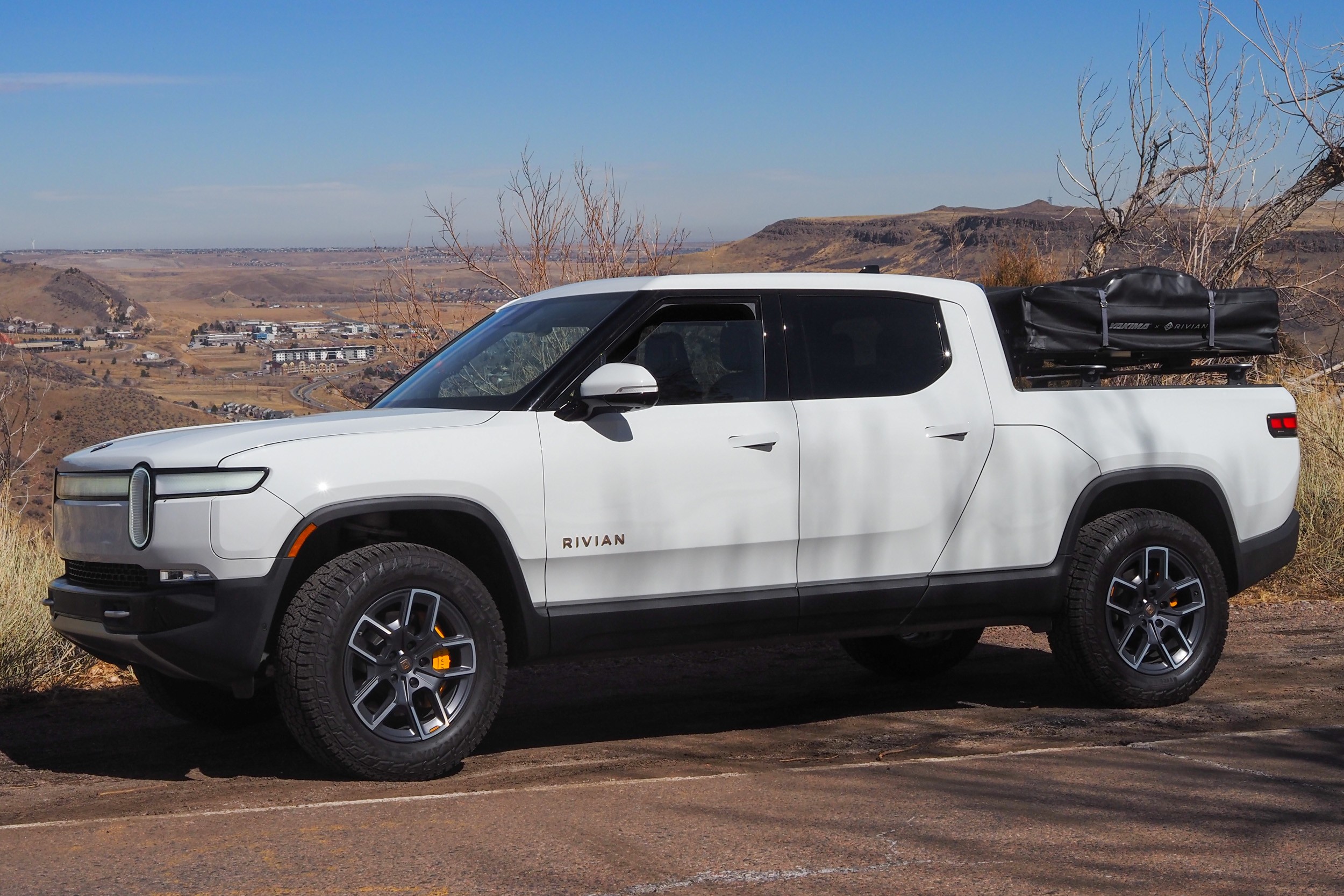
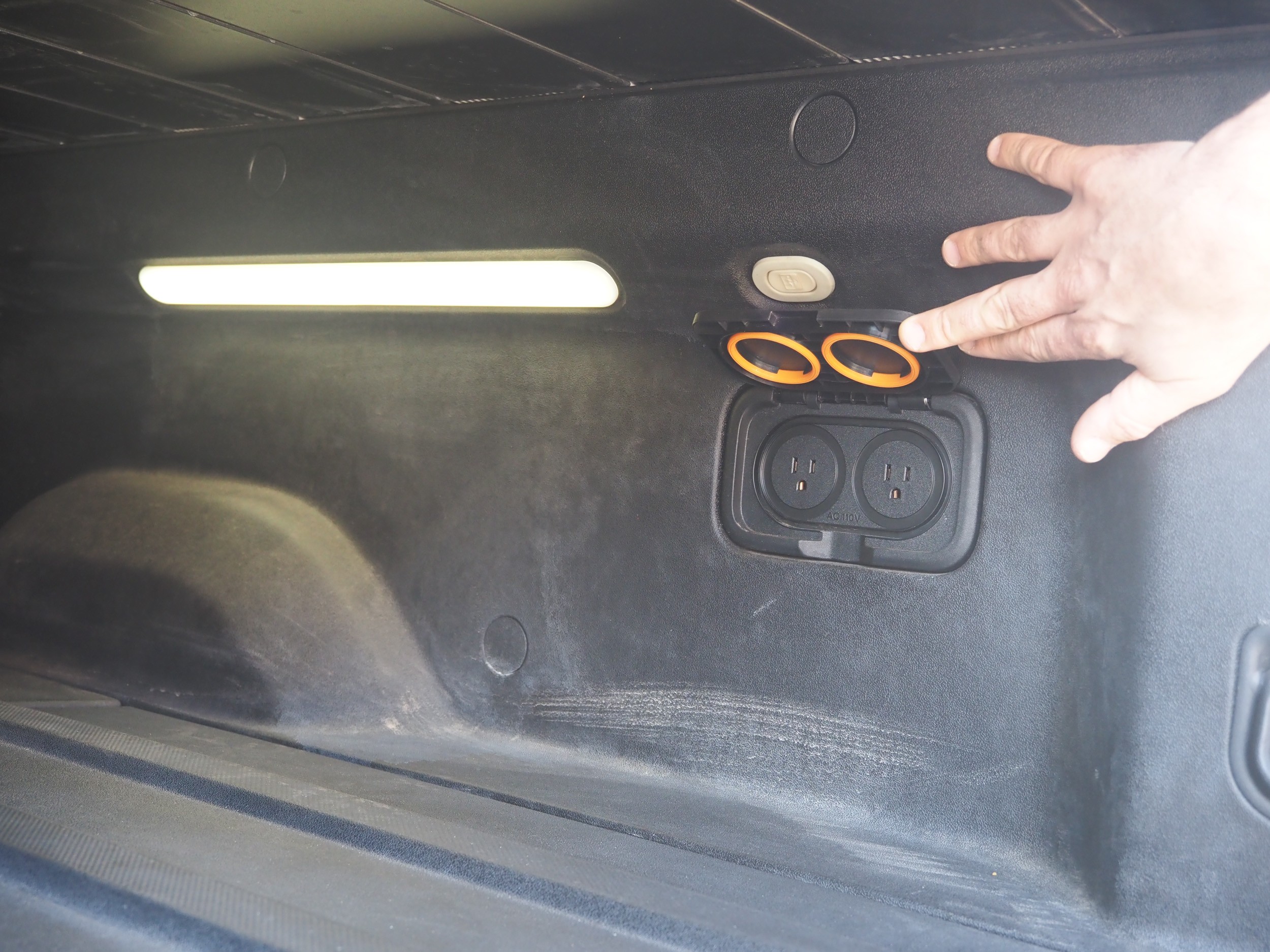 Rivian R1T-7
Rivian R1T-7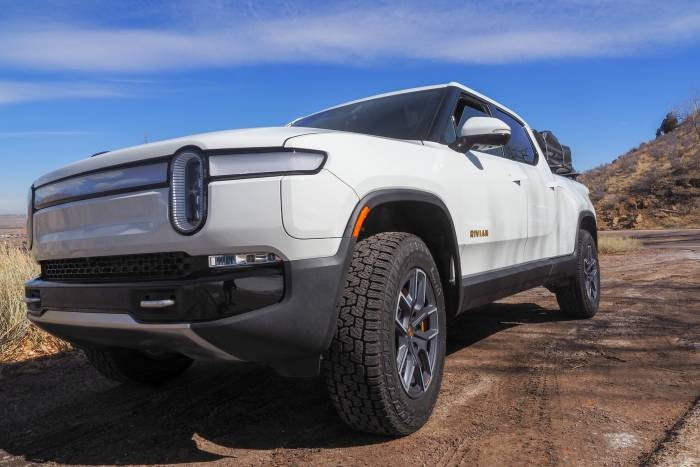 2022 Rivian R1T
2022 Rivian R1T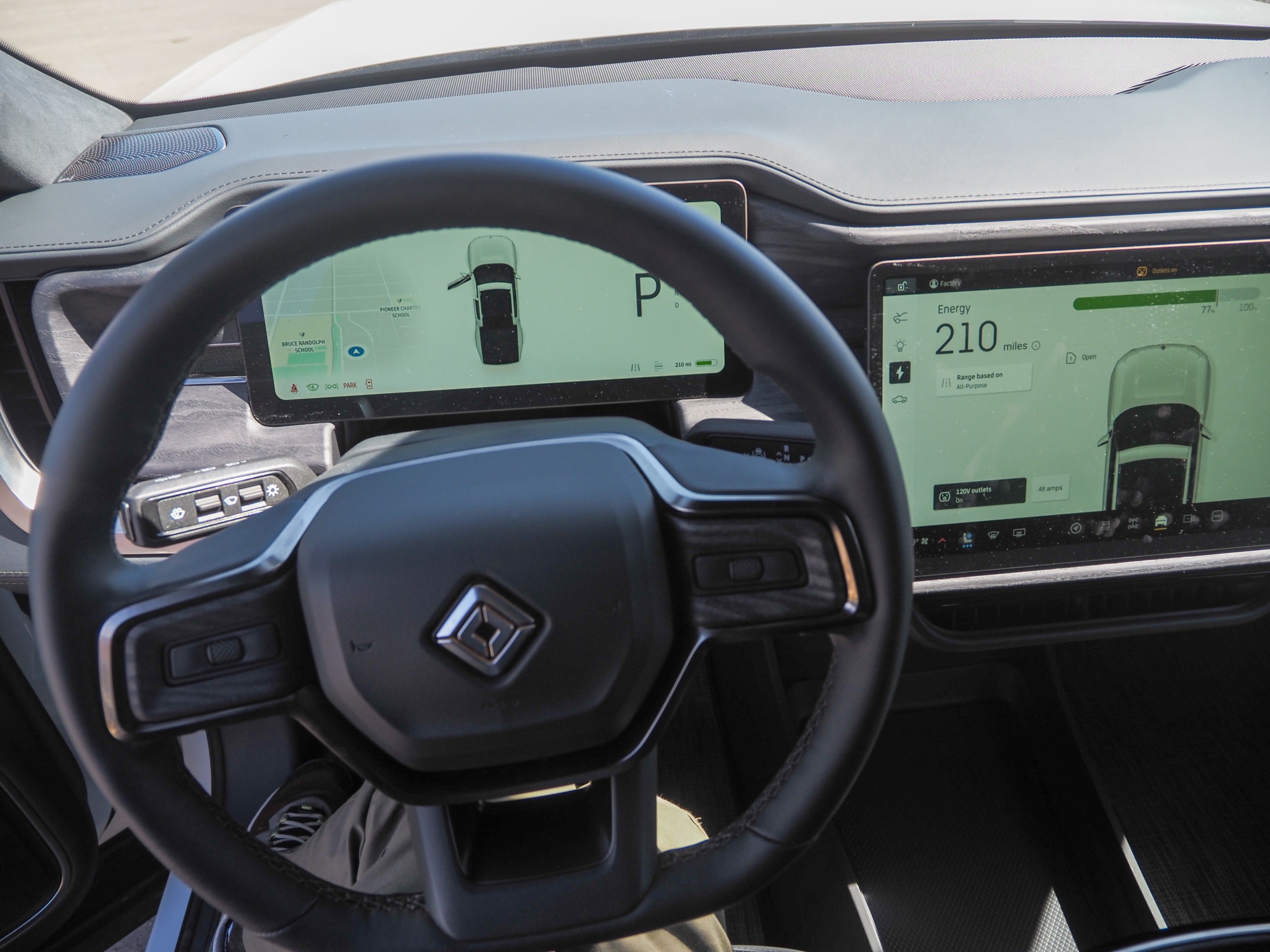 Rivian R1T-5
Rivian R1T-5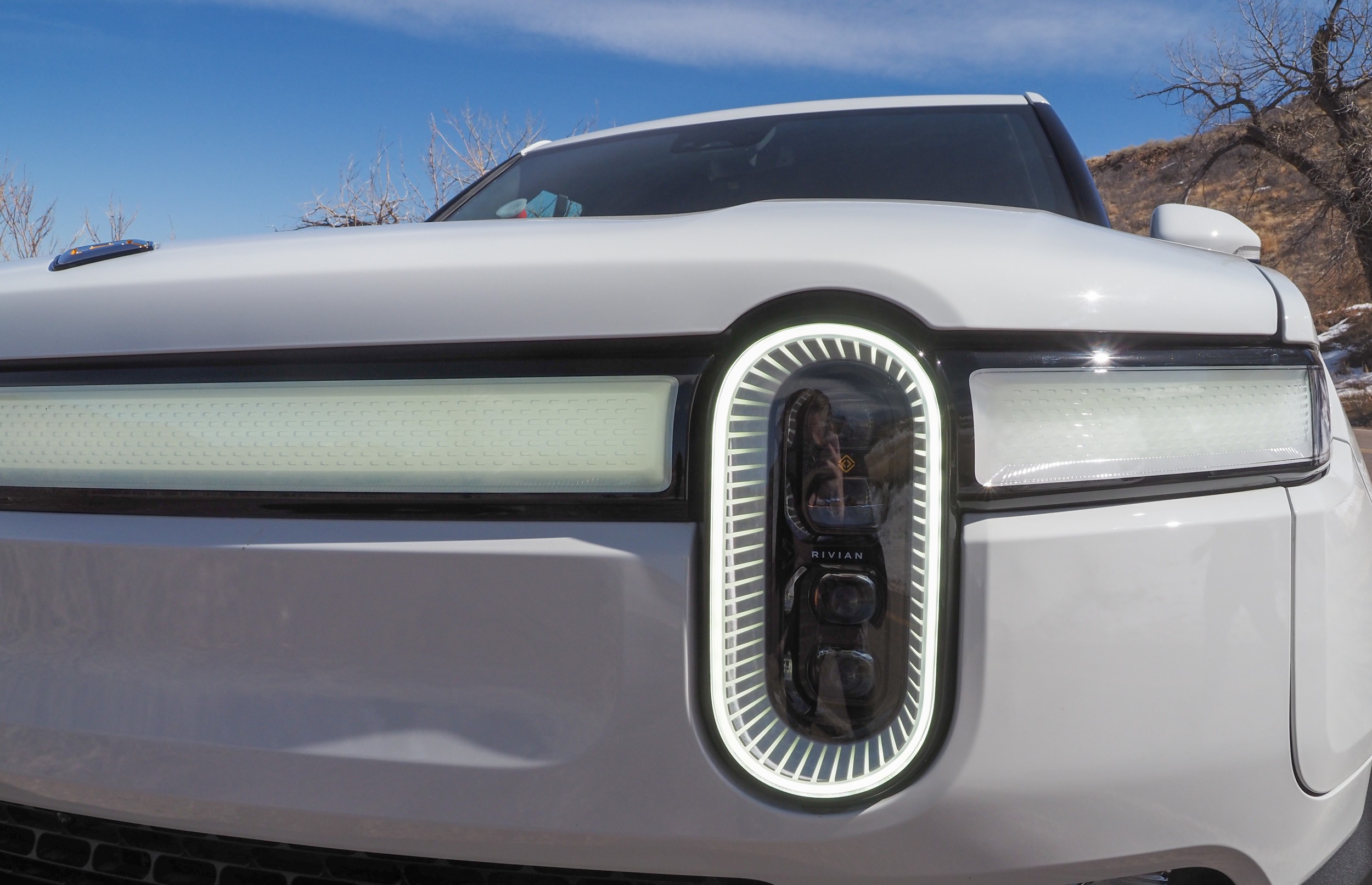 Rivian R1T-4
Rivian R1T-4